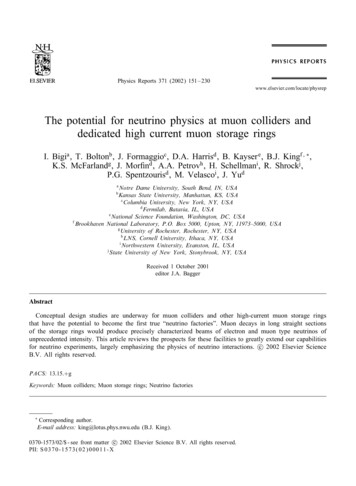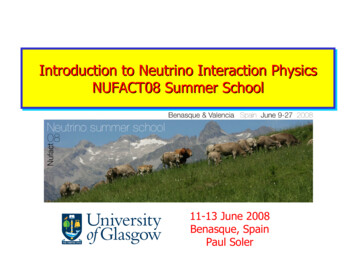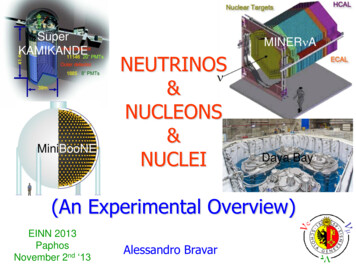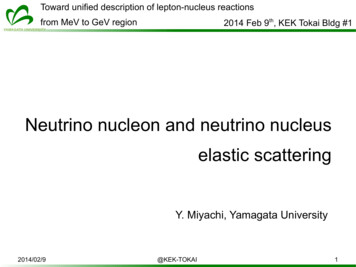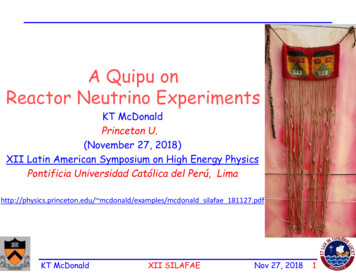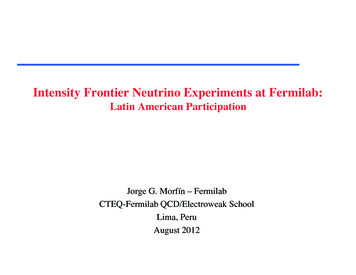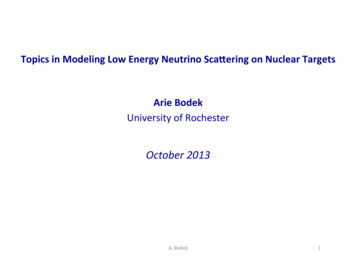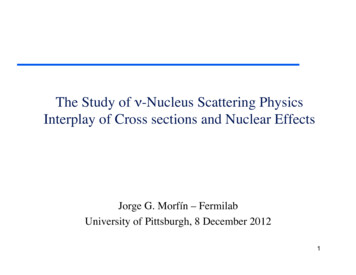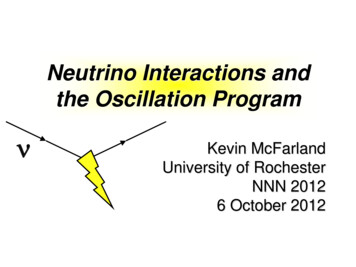
Transcription
Neutrino Interactions andthe Oscillation ProgramnKevin McFarlandUniversity of RochesterNNN 20126 October 2012
Neutrinos InteractionsnNeutrinos interactions are simple until they aren’t.νldW uLeptonic current is perfectly predicted in SM as is the hadronic current for free quarks.For exclusive, e.g., quasielastic scattering, hadroncurrent requires empiricalform factors.For inclusive scattering from anucleon, add PDFs for a robusthigh energy limit prediction(drawings courtesy G. Perdue)If the nucleon is part of a nucleus, it may be modified, offshell, bound, etc. Also, exclusive states are affected byinteractions of final state hadrons within the nucleus.6 October 2012K. McFarland, Neutrino Interactions2
Where’s My Spoonfulof Sugar?n Complications of interactionsare not always appealing. Accelerator oscillationexperiments require beamenergies of 0.3-5 GeV Nuclear response in this region makesthe transition between inelastic andelastic processes. First-principles calculations ofstrongly bound target areimpossible or unreliable.6 October 2012K. McFarland, Neutrino Interactions3
How do we Understand andModel cattering orrelatedprocesses) Iterative process, using data to improve models Models are effective theories, ranging from pureparameterizations of data to microphysicalmodels with simplifying assumptions.6 October 2012K. McFarland, Neutrino Interactions4
nHow do OscillationExperiments use Models?6 October 2012K. McFarland, Neutrino Interactions5
Oscillations: Large q13n Large q13 means high rate ofνμ νe But fractional CP asymmetrydecreases as q13 increases(Parke 2003, arXiv:0710.554)6 October 2012 Nature put us here As we all know, that puts us inthe position of having goodstatistics, but systematicsbecome more important.K. McFarland, Neutrino Interactions6
Oscillations: Needs (Hyper K)n Discovery of CP violation in neutrinooscillations requires seeing distortions ofP(νμ νe) as a function of neutrino andanti-neutrino energyOscillation Probabilities for L 295 km,Hyper-K LOI6 October 2012K. McFarland, Neutrino Interactions7
Oscillations: Needs (LBNE)n Maximum CP effect is range of red-blue curve Backgrounds are significant, vary with energy and aredifferent between neutrino and anti-neutrino beams Pileup of backgrounds at lower energy makes 2nd maximum onlymarginally useful in optimized design Spectral information plays a role CP effect may show up primarily as a rate decrease in one beamand a spectral shift in the other6 October 2012K. McFarland, Neutrino Interactions8
Oscillations: Near Detectorsn Near detectors are a powerful tool for constraininguncertainties in flux and cross-sections Limitations of even “perfect” near detectors:1. Flux is never identical near and far, because ofoscillations if for no other reason.2. Near detector has backgrounds to reactions of interestwhich may not be identical to far detector (see #1).3. Neutrino energy, on which the oscillation probabilitydepends, may be smeared or biased.4. Near detectors measure (dominantly) interactions ofmuon neutrinos when signal is electron neutrinos.6 October 2012K. McFarland, Neutrino Interactions9
Oscillations: Breaking theFlux & σ Degeneracyn Experiments have a, more or less, universalscheme for using the near detector data to getflux and cross-sectionExternal Hadroproductionand Beam SimulationNear DetectorRateMeasurementsSeparatedFlux andCrossSections6 October 2012External Cross-SectionMeasurements andModels Because of limitationsof near detectortechnique, these rely onaccurate modelsK. McFarland, Neutrino Interactions10
nCurrent Practices6 October 2012K. McFarland, Neutrino Interactions11
Neutrino Generators:“State of the Art”n GENIE, NUANCE, NEUT, NuWro are the generatorscurrently used in neutrino oscillation experiments. Share same approach, with minor variations Relativistic Fermi Gas in Initial State Free nucleon cross-sectionsRein-Sehgal[Ann. Phys. 133,79-153 (1981)]Llewellyn-Smith, PhysRept.scattering 3C, 261–379 (1972)o Llewellyn Smith formalism for quasi-elastico Rein-Sehgal calcluation/fit for resonance productiono Duality based models for deep inelastic scattering Cascade models for final state interactionsBodek-YangarXiV:1011.6592o Roughly, propagate final state particles through nucleus and allowthem to interact. Constrained by πN, NN measurements. Improvements (nuclear model, reaction models)are in progress, but behind “best” theory models.6 October 2012K. McFarland, Neutrino Interactions12
The Essential Tensionn Ulrich Mosel’s brilliant observation at NuINT11: Theorist’s paradigm: “A good generator does nothave to fit the data, provided [its model] is right” Experimentalist’s paradigm: “A good generator doesnot have to be right, provided it fits the data” Most of the generators currently used byoscillation experiments (NUANCE, GENIE,NEUT) are written and tuned by experimentalists See above! Our generators are wrong. WRONG! Models do not fit (all) the data, although theyprovide insight into features of this data6 October 2012K. McFarland, Neutrino Interactions13
What is Useful aboutGenerators?n This approach gives a set of four vectors forevery particle leaving the nucleus Essential for oscillation experiments where limiteddetectors have responses that vary wildly depending onfinal state particle Many tunable parameters, and it is always easyto add more Why? Initial model isn’t self-consistent anyway, soexperimenters just tune knobs to make data agreeo Which of course only applies to data we have and may ormay not be predictive for the future.6 October 2012K. McFarland, Neutrino Interactions14
What is Deadly AboutGenerators?n Difficult or impossible to put in a completecalculation for a single exclusive or semiinclusive final state. Even if that calculation is better, it may not be clearhow to factorize from the ensemble of reactions andeffects in the generator. As a result, generators lag developments in theory. No way to know a priori if range of tunableparameters that external data seems to allow isreally spans the difference between thegenerator and truth.6 October 2012K. McFarland, Neutrino Interactions15
What to do when models anddata don’t agree?n Most of these models give absolute predictions.So how to make them agree with data? MiniBooNE oscillationanalysis approach: Modify the dipole axialνμn μ-pPRD 81, 092005 (2010)mass and Pauli blockinguntil model fits data. But there is nothingfundamental behind thisapproach. It’s a mechanical convenience. Dipole formfactor is unlikely to be right, and changes in Pauliblocking are masking deficiencies in models!6 October 2012K. McFarland, Neutrino Interactions16
What to do when models anddata don’t agree? (cont’d)nRein-Sehgal[Ann. Phys. 133, 79-153 (1981)]implementation in NEUT“Tuned” Rein-Sehgalto modify Q2 distribution,pion spectrum, rate T2K studies νμN μ-π( )0N( ) and νμN νμπ0N and findspoor agreement between Rein-Sehgal calculation andMiniBooNE data Adds ad hoc tuning that “breaks” assumptions ofunderlying model, e.g. CC-NC universality of process andrelation among resonances, to force good agreement.6 October 2012K. McFarland, Neutrino Interactions17
nExample of Progress:Quasi-Elastic Models6 October 2012K. McFarland, Neutrino Interactions18
Quasi-Elastic EnergyReconstructionn Quasi-elastic reaction allows neutrinoenergy to be determined from only theoutgoing lepton: This assumes: A single target nucleon, motionless in apotential well (the nucleus) Smearing due to the nucleus is typically builtinto the cross-section model since it cannot beremoved on an event-by-event basis.6 October 2012K. McFarland, Neutrino Interactions19
Modeling the Nucleon in aNucleusn Our models come from theory tuned toelectron scattering Generators usually use Fermi Gas model,which takes into account effect of themean field.- 12 Corrections to electrondata from isospineffects in neutrinoscattering.e C e XE. Moniz et al,PRL 26, 445 (1971)6 October 2012K. McFarland, Neutrino Interactions20
Mean Field Approximation? There are many hintsthat the mean fieldapproach isn’t sufficient. EMC effect: modification ofinclusive cross-section Recently, study of “size” of EMCeffect in nuclei led to theconclusion that effect seems tovary with local rather thanglobal density of nucleusnJ. Seely et al.,PRL 103,202301(2009)9Beis twotightlybound αloosely heldwith aneutron(Figure courtesy APS PhysRev Focus)6 October 2012K. McFarland, Neutrino Interactions21
Short-Range CorrelationsnRecent Jlab studies of 12C quasielastic scattering have demonstratedsignificant probabilities to see multiplenucleons knocked out beyondexpectation from final stateinteractions.[R. Subedi et al.,Science 320, 1476 (2008)] Kinematics of interaction may be altered becausescattering in nuclear environment occurs from acorrelated pair 20% of the time. Dekker et al., PLB 266, 249 (1991)Singh, Oset, NP A542, 587 (1992) Not a new idea to apply toGil et al., NP A627, 543 (1997)J. Marteau, NPPS 112, 203 (2002)quasi-elastic scattering.Nieves et al., PRC 70, 055503 (2004)Evidence in charged leptonMartini et al., PRC 80, 065001 (2009)scattering now strengthens the case.6 October 2012K. McFarland, Neutrino Interactions22
Origin of MiniBooNE CCQE“Axial Mass”?n From the 12C experiment and calculations,expect a cross-section enhancement fromcorrelated process:νμn μ-p νμ(np)corr. μ-ppNew work since Martini proposalNieves et al., arXiv:1106.5374 [hep-ph]Bodek et al., arXiv:1106.0340 [hep-ph]Amaro, et al., arXiv:1104.5446 [nucl-th]Martini et al,Antonov, et al., arXiv:1104.0125PRC 81, 045502 (2010)Benhar, et al., arXiv:1103.0987 [nucl-th]Meucci, et al., Phys. Rev. C83, 064614 (2011)Ankowski, et al., Phys. Rev. C83, 054616 (2011)Nieves, et al., Phys. Rev. C83, 045501 (2011)Amaro, et al., arXiv:1012.4265 [hep-ex]Alvarez-Ruso, arXiv:1012.3871[nucl-th]Benhar, arXiv:1012.2032 [nucl-th]Martinez, et al., Phys. Lett B697, 477 (2011)Amaro, et al., Phys. Lett B696, 151 (2011)Martini, et al., Phys. Rev C81, 045502 (2010)K. McFarland, Neutrino Interactions23[compilation by G.P. Zeller]Δσ6 October 2012
Modeling Multi-nucleonCorrelationsn There are several microphysical calculations on themarket, but they share several key features. They are all based on effective theories valid over limitedranges of energy, kinematics. Theoretical systematics aredifficult to control. Calculations are just starting to see effect in the right set ofvariables (inclusive lepton energy and angle) for highprecision comparison with data or to predict the kinematic effects! My personal conclusion: calculations need moreexperimental validation before they are reliable. Good news: lots of data soon to be available. Bad news: difficult to directly observe energy smearing.6 October 2012K. McFarland, Neutrino Interactions24
Parameterizing MultiNucleon Correlationsn Independent of models,can look for the effect inelectron scattering Should show up as anenhancement to thetransverse scatteringcross-section on nuclei notseen on free nucleons Do we learn enough fromelectron scattering dataalone about the kinematicdetails? Probably not.A. Bodek, H.S. Budd, M.E. ChristyEur.Phys.J. C71 (2011) 17266 October 2012K. McFarland, Neutrino Interactions25
Can we see this withneutrinos?n Liquid argon has excellentresolution for final state Example: ArgoNeuT, a smallliquid argon TPC test in NuMI beamlineJ. Spitz, arXiv: 1009.2515v1m pFigures courtesy M. Soderberg and G.P. Zellerm p p6 October 2012 Other detectors capable ofseeing recoil protons can(and will) look for this Difficulty will be separationof the effects of final stateinteractions from initial statecorrelations Promising line of studyK. McFarland, Neutrino Interactions26
Energy Reconstruction:Quasi-Elasticn How does it quantitatively matter if we model this as aneffective axial mass or microphysically? Inferred neutrino energy changes if target is multinucleon.Lalakulich, Gallmeister, Mosel,1203.2935ex: Mosel/Lalakulich 1204.2269, Martini et al. 1202.4745,Lalakulich et al. 1203.2935, Leitner/Mosel PRC81, 064614 (2010)6 October 2012K. McFarland, Neutrino Interactions27
nOther Puzzles and Progress6 October 2012K. McFarland, Neutrino Interactions28
Energy Reconstruction:Inelasticn Here the problem is actually worse Detector energy response varies Neutrons often exit without interacting Proton and alpha ionization saturates π- capture on nuclei at rest, π decay, π0 decay tophotons and leave their rest mass in detector Any detector, even liquid argon, will onlycorrectly identify a fraction of the final state Need to know details of final state in four vector andparticle content to correct for response6 October 2012K. McFarland, Neutrino Interactions29
What We Want to Knowabout Pionsn What happens to our nucleonlevel prediction when youhide the target in a nucleus?CC π (O. Lalakulich, ECT, Hadrons inthe Nuclear Medium) Is our model of pion productionfrom free nucleons accurate?[Rein & Sehgal, Ann. Phys. 133, 79-153 (1981)]If we only study pion productionon nuclei, can we ever cleanlyseparate the free-nucleon crosssection from final state effects?6 October 2012K. McFarland, Neutrino Interactions30
Updating Rein-Sehgal?n Vector form factors can be updated to giveimprovementJ. Nowak, NuInt09:Comparisons betweenseveral updated formfactors and (prelim.) MBCC1π data. Also addedlepton mass.We are now here Can retune to D2 data, particularly toimprove non-resonant component631October 2012K. McFarland, Neutrino Interactions
Final State Interactionsn Most generators implement a semi-classical cascademodel of transport for FSI. E.g., NEUT:MiniBooNECC1pi DataPion-C scattering data comparedto NEUT’s tuned modelFigures and analysis from P. dePerio, NuINT11 But attempts to retune still don’t reproduce precise data.Is it nucleon-level model or is it simplicity of FSI model? How can we distinguish between the two problems?6 October 2012K. McFarland, Neutrino Interactions32
Models for Short-RangeCorrelations, EMC Effect n A major goal is to make reliablemeasurements analogous toEMC in neutrino scattering Different models of EMC effecthave varying predictions forneutrinos“EMC effect” Fe/D2 ratio of F2ν. Ratio of bubble chamber experiments(FNAL/CERN) to CDHS (CERN) Challenging because of different beamflux, low statistics in bubble chambers. After 30 years, time to advance.6 October 2012K. McFarland, Neutrino Interactions33
MINERvA’s Fe/Pb Ration Measurement technique uses ratiosof passive target to nearbyscintillator to reduce uncertaintiesCandidate twotrack event frompassive target Early days so far, Pb/Fe few% ofexposure to validate theexperimental technique Also, MINERvA plans a long run athigher beam energyPbCH #2FeCH #1 Ratios, as expected, largely free ofreconstruction and flux uncertainties6 October 2012K. McFarland, Neutrino Interactions34
Lepton Mass in QuasiElastic ScatteringnMelanie Day and KSM,Phys.Rev. D86 (2012) 053003 Differences arise from kinematic limits and mass-dependent terms. Uncertainties in form factors of nucleon lead to uncertainties in thedifferences of muon and electron neutrino reaction rates. Six allowed form factors of the nucleon that enter: Two “ordinary” vector and one axial form factoro Vector form factors can be measured in electron scattering.Axial form factor from pion leptoproduction, neutrino CCQE on D2. One pseudoscalar form factoro Predicted by PCAC and Goldberger-Treiman to be smallo Experimental tests of these assumptions exist. One vector and one axial “second class” currento Assumed to be zero because they violate charge symmetry (not aperfect symmetry, e.g., mn mp) in nucleon system.o Constrained (poorly) from beta decay and muon capture.6 October 2012K. McFarland, Neutrino Interactions35
Results for Neutrino CrossSection Differencesn Possible effect from F3V of few % at J-PARC to HKChange in FractionalCross-Section Difference Neutrino and anti-neutrino effects are opposite in sign for secondclass currents, so could fake a CP asymmetry.6 October 20121% effect for J-PARC toHyper-Kamiokande hereK. McFarland, Neutrino InteractionsM. Day & KSM,Phys.Rev. D86 (2012) 05300336
nConclusions6 October 2012K. McFarland, Neutrino Interactions37
Interactions and FutureOscillation Experimentsn Models of neutrino interactions arenecessary for oscillation experiments. Obtaining accurate models of neutrinointeractions at required energies is adifficult problem. Interplay of data, including new data fromMINERvA, T2K, MicroBooNE, NOvA, withtheory is essential to progress.6 October 2012K. McFarland, Neutrino Interactions38
nBackup6 October 2012K. McFarland, Neutrino Interactions39
Llewellyn SmithQuasi-Elastic Scatteringn Avert your gaze Two terms, including those with FP, and F3V, enter with afactor of m2/M2. These are relevant for muon neutrinosat low energies but not for electron neutrinos.6 October 2012K. McFarland, Neutrino Interactions40
MiniBooNEn νe appearance with aconventional (meson decay)wide-band beam Significant backgroundsfrom neutral currents (π0s),but are measured in situ(G.P. Zeller)p0 backgroundfrom En Enrecoνe backgrounds Signal identification is exclusive quasi-elastic. Leptonkinematics used to infer neutrino energy. Parameters of signal reaction constrained with muon neutrinoquasi-elastic sample6 October 2012K. McFarland, Neutrino Interactions41
T2Kn νe appearance with a conventional(meson decay) narrow-band beam Backgrounds from neutral currents(π0s), but here rate is too low toconstrain in far detectoro Fit external data to constrain production Signal identification is also restrictiveand use lepton kinematics to inferneutrino energy, as with MiniBooNE Even after near detectorconstraint, still have significantuncertainties from interactions.6 October 2012K. McFarland, Neutrino Interactions(T. Nakaya, Neutrino 2012)42
A Long-Standing Puzzle:The EMC Effectn Charged lepton F2A/F2Dshows convincinglymodification of quarkdistributions in a nucleus No model of nucleus as anincoherent sum of nucleonscan reproduce this effect. No conclusive model of thecollective behavior exists.“EMC effect”(D. Gaskell, ECT*, Hadrons in the Nuclear Medium) Empirically, we know that the qualitative dependence onx is the same for all nuclei But size of effect varies with the nucleus studied6 October 2012K. McFarland, Neutrino Interactions43
“Axial Mass Puzzle”n As described earlier, MA has been measured to be1.03 GeV/c2 in νD2 and pion electroproduction A slew of low energy data (MiniBooNE, SciBooNE, K2K)prefers a higher axial mass and therefore higher σ What is going on in the nuclear environment to createthis effect?Posters:Alcaraz et al, AIPConf. Proc.1189.145 (2009)MINOS205-1(progress report)MiniBooNE119-2(outside fits toMiniBooNE)6 October 2012K. McFarland, Neutrino Interactions44
First MINERvA Result!nAnti-neutrino CCQE on scintillator (CH)n candidate nmp m ncandidateEven with current systematics (willimprove), clear trends in data MA 1.35 disfavored; low Q2 dipCalorimetricrecoil energy(only neutronfor signal)NuWro: T.Golan, C. Juszczak,J. Sobczyk. arXiv:1202.4197Background6 October 2012K. McFarland, Neutrino Interactions45
Neutrino and AntiNeutrino in Energy BinsnQ2 distributions compared to GENIE, MA 0.99 GeV/c2LowEnergy,2-4 GeVnnSimilar trendsin Q2 in bothbeams, energiesPoster132-320% of ourdata on CHnnHighEnergy,4-10 GeV6 October 2012K. McFarland, Neutrino Interactions46
MINERvA’s TargetsTarget 5Target 4Water TargetTarget 3Target 2Target 1“1”6 October 2012“2”“3”He“4”“5”n Goal: High statisticsratios of Fe/Pb/C/O/Hein identical flux Extract x-dependentnuclear effects as afunction of A! Targets surrounded byactive scintillator. Some thick targets for“high” rate. Also thin targets forexclusive final states.K. McFarland, Neutrino Interactions47
Neutrino energy, on which the oscillation probability depends, may be smeared or biased. 4. Near detectors measure (dominantly) interactions of muon neutrinos when signal is electron neutrinos. 6 October 2012 K. McFarland, Neutrino Intera

